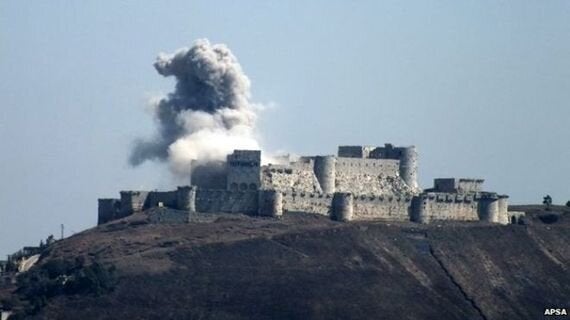
Krak des Chevaliers castle near Homs
The recapture of the ancient city of Palmyra by forces loyal to the Assad regime is being celebrated by many as a good sign that some of Syria's most treasured ruins might be saved.Units of Lebanese Hezbollah, Iranian Revolutionary Guards, Shi'ite foreign militias and what remains of the Syrian military took Palmyra with Russian air support on Sunday after a less than two months siege of the city. The so-called Islamic State group took control of the city last May, when Assad's forces curiously retreated from it.
IS destroyed a number of important ancient objects, building and artefacts, including the Temple of Bel and the Arch of Triumph, which has led to calls for archaeological experts to head out to the region to assess the damage and possibly restore the sites http://www.theguardian.com/world/2016/mar/28/palmyra-after-isis-images-taken-following-syrian-recapture-offer-hope-amid-ruins. Boris Johnson wrote in the Daily Telegraph, "Bravo for Assad- he is a vile tyrant but he saved Palmyra from Isil. http://www.telegraph.co.uk/news/worldnews/middleeast/syria/12205262/Bravo-for-Assad-he-is-a-vile-tyrant-but-he-has-saved-Palmyra-from-Isil.html" But while the thought of Palmyra being restored is encouraging, we should not forget that most of Syria's treasured sites were either damaged or destroyed by the Assad regime and not by the Islamic State group.
Syria boasts some 6, 500 ancient sites which range from Neolithic settlements to medieval mosques according to National Geographic http://news.nationalgeographic.com/2015/11/151125-isis-syria-satellite-images-looting-archaeology/. Teams of American archaeologists using satellite images of 1, 450 ancient sites found that one in four have been damaged or looted since 2011. Half of these sites are located in rebel and Kurdish held areas, a quarter in IS controlled territory and the rest in areas loyal to the Assad regime. But what these finding ignore is the simple fact that many of these ancient sites are located in scarcely populated areas, which the regime cannot put its resources into controlling and thus by circumstance come under opposition rule, the Assad regime only held 17% of Syria in 2015 when this study was done (although this has gone up slightly since) http://www.janes.com/article/53771/syrian-government-no-longer-controls-83-of-the-country. More importantly opposition areas are much more intensely bombed than regime held areas are. Some of the most important and iconic ancient sites were destroyed by Assad's forces.
Krak des Chevaliers (Qalat al Hosn) the famous crusader castle located a few miles from the city of Homs, which had been a favourite haunt for tourists due to how well preserved the castle was- often said to be the best castle in the region. It was severely damaged by Assad regime air strikes and mortar fire in 2013, the full extent of the damage is unknown, but videos of the castle engulfed by smoke are readily available http://www.middle-east-online.com/english/?id=60073. Al-Madina Souq in Aleppo which was the largest covered historical market in the world and it was destroyed when it caught fire after being shelled by regime forces in 2012 http://www.irishtimes.com/news/souk-burns-as-aleppo-fight-rages-1.739507. Archaeological sites in the 'Dead Cities' region of northern Syria was severely damaged by regime forces in 2011 and 2012 during their attempts to root out opposition forces and army deserters. The former Roman city of Bosra with its many heritage sites was heavily destroyed or damaged by regime tanks and artillery fire http://ghn.globalheritagefund.com/uploads/documents/document_2107.pdf. There are many more examples like this that have come out of this conflict. Of course, this is without mentioning the fact that in 1982 the Assad regime destroyed most of the old city of Hama, which they did after they had defeated the Muslim brotherhood inspired insurrection against the Syrian regime.
The point here is that the Assad regime has a very long history of destroying Syria's heritage sites. However with the ascent of the so-called Islamic State, the crimes against heritage committed by the Assad regime go unnoticed and it creates questionable euphoria when places like Palmyra are captured. These heritage sites are important for both economic and spiritual reasons; the future Syrian economy will be greatly helped by tourism and trade that these sites attract. But more importantly it provides Syria with its unique identity, it gives it a past which is free from both the tyranny of IS and the Assad regime, it tells a series of stories about our human past and offers insight into what our future's might be. Crimes committed against it are not only crimes against the Syrian people but crimes against humanity too. Assad should not get a free pass just because he is not ISIS.